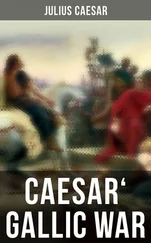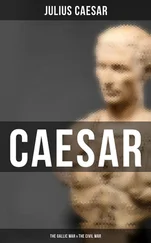Napoleon III - History of Julius Caesar Vol. 2 of 2
Здесь есть возможность читать онлайн «Napoleon III - History of Julius Caesar Vol. 2 of 2» — ознакомительный отрывок электронной книги совершенно бесплатно, а после прочтения отрывка купить полную версию. В некоторых случаях можно слушать аудио, скачать через торрент в формате fb2 и присутствует краткое содержание. Жанр: foreign_antique, foreign_prose, Биографии и Мемуары, на английском языке. Описание произведения, (предисловие) а так же отзывы посетителей доступны на портале библиотеки ЛибКат.
- Название:History of Julius Caesar Vol. 2 of 2
- Автор:
- Жанр:
- Год:неизвестен
- ISBN:нет данных
- Рейтинг книги:4 / 5. Голосов: 1
-
Избранное:Добавить в избранное
- Отзывы:
-
Ваша оценка:
- 80
- 1
- 2
- 3
- 4
- 5
History of Julius Caesar Vol. 2 of 2: краткое содержание, описание и аннотация
Предлагаем к чтению аннотацию, описание, краткое содержание или предисловие (зависит от того, что написал сам автор книги «History of Julius Caesar Vol. 2 of 2»). Если вы не нашли необходимую информацию о книге — напишите в комментариях, мы постараемся отыскать её.
History of Julius Caesar Vol. 2 of 2 — читать онлайн ознакомительный отрывок
Ниже представлен текст книги, разбитый по страницам. Система сохранения места последней прочитанной страницы, позволяет с удобством читать онлайн бесплатно книгу «History of Julius Caesar Vol. 2 of 2», без необходимости каждый раз заново искать на чём Вы остановились. Поставьте закладку, и сможете в любой момент перейти на страницу, на которой закончили чтение.
Интервал:
Закладка:
They reckon from Villefranche to Remilly about 170 kilomètres.
183
Each soldier received twenty-five pounds of wheat every fortnight.
184
It is generally admitted that Bibracte stood on the site of Autun, on account of the inscription discovered at Autun in the seventeenth century, and now preserved in the cabinet of antiquities at the Bibliothèque Impériale. Another opinion, which identifies Bibracte with Mont Beuvray (a mountain presenting a great surface, situated thirteen kilomètres to the west of Autun), had nevertheless already found, long ago, some supporters. It will be remarked first that the Gauls chose for the site of their towns, when they could, places difficult of access: in broken countries, these were steep mountains (as Gergovia, Alesia, Uxellodunum, &c.); in flat countries, they were grounds surrounded by marshes (such as Avaricum). The Ædui, according to this, would not have built their principal town on the site of Autun, situated at the foot of the mountains. It was believed that a plateau so elevated as that of Mont Beuvray (its highest point is 810 mètres above the sea) could not have been occupied by a great town. Yet the existence of eight or ten roads, which lead to this plateau, deserted for so many centuries, and some of which are in a state of preservation truly astonishing, ought to have led to a contrary opinion. Let us add that recent excavations leave no further room for doubt. They have brought to light, over an extent of 120 hectares, foundations of Gaulish towers, some round, others square; of mosaics, of foundations of Gallo-Roman walls, gates, hewn stones, heaps of roof tiles, a prodigious quantity of broken amphoræ, a semicircular theatre, &c… Everything, in fact, leads us to place Bibracte on Mont Beuvray: the striking resemblance of the two names, the designation of Φροὑριον, which Strabo gives to Bibracte, and even the vague and persistent tradition which, prevailing among the inhabitants of the district, points to Mont Beuvray as a centre of superstitious regard.
185
The cavalry was divided into turmæ , and the turma into three decuries of ten men each.
186
The word sarcinæ , the original sense of which is baggage or burthens, was employed sometimes to signify the bundles carried by the soldiers ( De Bello Gallico , II. 17), sometimes for the heavy baggage ( De Bello Civili , I, 81). Here we must take sarcinæ as comprising both. This is proved by the circumstance that the six legions of the Roman army were on the hill. Now, if Cæsar had sent the heavy baggage forward, towards Bibracte, as General de Gœler believes, he would have sent with it, as an escort, the two legions of the new levy, as he did, the year following, in the campaign against the Nervii. ( De Bello Gallico , II. 19.)
187
De Bello Gallico , I. 24. – In the phalanx, the men of the first rank covered themselves with their bucklers, overlapping one another before them, while those of the other ranks held them horizontally over their heads, arranged like the tiles of a roof.
188
According to Plutarch ( Cæsar , 20), he said, “I will mount on horseback when the enemy shall have taken flight.”
189
The pilum was a sort of javelin thrown by the hand: its total length was from 1·70 to 2 mètres; its head was a slender flexible blade from 0·60 to 1 mètre long, weighing from 300 to 600 grammes, terminating in a part slightly swelling, which sometimes formed a barbed point.
The shaft, sometimes round, sometimes square, had a diameter of from 25 to 32 millimètres. It was fixed to the head by ferules, or by pegs, or by means of a socket.
Such are the characteristics presented by the fragments of pila found at Alise. They answer in general to the descriptions we find in Polybius (VI. 28), in Dionysius (V. 46), and in Plutarch ( Marius ). Pila made on the model of those found at Alise, and weighing with their shaft from 700 grammes to 1·200 kilog., have been thrown to a distance of 30 and 40 mètres: we may therefore fix at about 25 mètres the average distance to which the pilum carried.
190
Latere aperto , the right side, since the buckler was carried on the left arm. We read, indeed, in Titus Livius: “Et cum in latus dextrum, quod parebat, Numidæ jacularentur, translatis in dextrum scutis,” &c. (XXII. 50.)
191
Dio Cassius (XXXVIII. 33) says on this subject that “the Helvetii were not all on the field of battle, on account of their great number, and of the haste with which the first had made the attack. Suddenly those who had remained in the rear came to attack the Romans, when they were already occupied in pursuing the enemy. Cæsar ordered his cavalry to continue the pursuit; with his legions, he turned against the new assailants.”
192
Plutarch, Cæsar , 20.
193
De Bello Gallico , I. 26. – Till now the field of battle where Cæsar defeated the Helvetii has not been identified. The site which we have adopted, between Luzy and Chides, satisfies all the requirements of the text of the “Commentaries.” Different authors have proposed several other localities; but the first cause of error in their reckonings consists in identifying Bibracte with Autun, which we cannot admit; and further, not one of these localities fulfils the necessary topographical conditions. In our opinion, we must not seek the place of engagement to the east of Bibracte, for the Helvetii, to go from the Lower Saône to the Santones, must have passed to the west, and not to the east, of that town. Cussy-la-Colonne, where the field of battle is most generally placed, does not, therefore, suit at all; and, moreover, Cussy-la-Colonne is too near to the territory of the Lingones to require four days for the Helvetii to arrive there after the battle.
194
“He drove back this people into their country as a shepherd drives back his flock into the fold.” (Florus, II. x. 3.)
195
De Bello Gallico , I. 29.
196
Cæsar pursued the Helvetii, taking for auxiliaries about 20,000 Gaulish mountaineers. (Appian, De Rebus Gallicis , IV. 15, edit. Schweigh.)
197
Appian, De Bello Celt. , IV. i. 3.
198
Tacitius ( Germania , iv. 32.) speaks of this custom of the German horsemen of fighting on foot. Titus Livius (XLIV. 26) ascribes this practice to the Bastarni (the Moldavians.)
199
Appian, De Bello Celt. , IV. i. 3.
200
De Bello Gallico , IV. 1, 2, 3. – General de Gœler, in our opinion, extends the territory of the Ubii much too far to the south.
201
De Bello Gallico , VI. 25. – This statement agrees well enough with the length of the Black Forest and the Odenwald, which is sixty leagues.
202
It is difficult to fix with precision the localities inhabited at this period by the German peoples, for they were nearly all nomadic, and were continually pressing one upon another. Cæsar, in his fourth book De Bello Gallico (cap. I), asserts that the Suevi never occupied the same territory more than one year.
203
Strabo (VII., p. 244) relates, after Posidonius, that the Boii had inhabited first the Hercynian forest; elsewhere he says (V. 177) that the Boii established themselves among the Taurisci, a people dwelling near Noricum. The same author (VII. 243) places the solitudes inhabited by the Boii to the east of Vindelicia ( Southern Bavaria and Western Austria ). Lastly, he says (IV. 471) that the Rhætii and the Vindelicii are the neighbours of the Helvetii and the Boii. The Nemetes and the Vangiones subsequently passed over to the left bank of the Rhine, towards Worms and Spire, and the Ubii towards Cologne.
Читать дальшеИнтервал:
Закладка:
Похожие книги на «History of Julius Caesar Vol. 2 of 2»
Представляем Вашему вниманию похожие книги на «History of Julius Caesar Vol. 2 of 2» списком для выбора. Мы отобрали схожую по названию и смыслу литературу в надежде предоставить читателям больше вариантов отыскать новые, интересные, ещё непрочитанные произведения.
Обсуждение, отзывы о книге «History of Julius Caesar Vol. 2 of 2» и просто собственные мнения читателей. Оставьте ваши комментарии, напишите, что Вы думаете о произведении, его смысле или главных героях. Укажите что конкретно понравилось, а что нет, и почему Вы так считаете.












